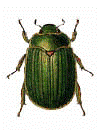Museum, University of Nebraska State
Document Type
Article
Date of this Version
11-27-2004
Abstract
Considering the turmoil and vast changes in the classification of the superfamily Scarabaeoidea during the last 20 years, particularly in North America, we were asked to provide an update for the readers of Scarabs wherein we offer our perspectives. Much of what follows is extracted from our scarabaeoid introduction in American Beetles (Jameson and Ratcliffe 2002). By the time this overview is printed, there may have been more changes in the classification because of the rapidly accumulating evidence supporting new hypotheses.
These rapid changes are a result of intensified study of the family groups using both traditional morphological evidence combined with increasingly insightful molecular studies. While possibly disruptive now, these new studies are exciting because, for the first time, we are establishing the higher classification of the Scarabaeoidea based on evidence and facts rather than intuition. This research confirms many of our hypotheses of classification but also clearly refutes others. Be on the lookout for future publications by Team Scarab and David Hawks!
The superfamily Scarabaeoidea is a large, diverse, cosmopolitan group of beetles. As a personal aside (and, of course, with no bias), these are probably the finest beetles in the world. Scarabaeoids are adapted to most habitats, and they can be fungivores, herbivores, necrophages, coprophages, saprophages, and sometimes carnivores. They are widely distributed around the globe, even living in the Arctic in animal burrows. Some scarabs exhibit parental care and sociality.Some are myrmecophilous, termitophilous, or ectoparasitic. Many possess extravagant horns, others are able to roll into a compact ball, and still others are highly armored for inquiline life. A very few are occasionally agricultural pests that may destroy crops (even beetles have to eat!) while others are used in the biological control of dung and dung flies. Scarabaeoids are popular beetles due to their large size, bright colors, and interesting natural histories. Early Egyptians revered the scarab as a god, Jean-Henri Fabre studied their behavior, and Charles Darwin used observations of scarabs in his theory of sexual selection.
What characterizes a scarabaeoid? The antennal club is lamellate, the prothorax is often highly modified for burrowing (with large coxae, usually with concealed trochantins and closed cavities), the protibia is usually dentate with a single spur, the wing venation is reduced and with a strong intrinsic spring mechanism for folding, tergite 8 forms a true pygidium and is not concealed by tergite 7, there are four Malpighian tubules, and larvae are scarabaeiform (cylindrical, cshaped).



Comments
Published in Scarabs Occasional Issue Number 15, November, 2004. A publication of The Coleopterists Society. Online at http://www.coleopsoc.org/nwslttrs.shtml